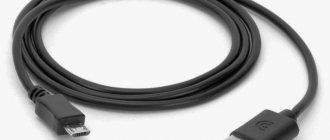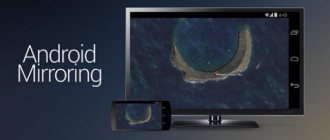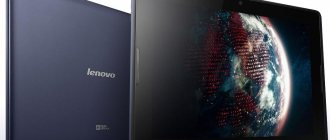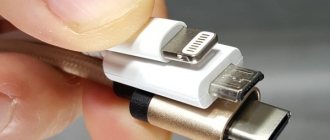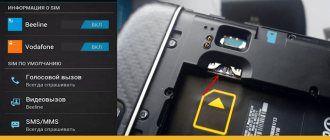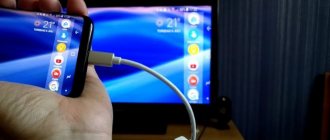In an effort to differentiate their smartphones from competitors' products, mobile equipment manufacturers sometimes make quite extraordinary decisions. One of the most unexpected new products of 2019 is a smartphone equipped with a tiny pico projector. The idea of implementing a projector itself is not new, but previously gadgets with projectors rarely reached mass sale, most of them remaining at the stage of bright concepts.
In this article we will talk about existing and affordable smartphones with projectors, promising concepts and notable models of past years.
Blackview Max 1
- Processor : 8-core MediaTek Helio P23
- Operating system : Android 8.1
- Screen : 6.01 inches, resolution 2160x1080
- Memory (RAM / User): 6 GB / 64 GB
- Battery : 4680 mAh
Price: from 25,990 rub.
The brainchild of the Chinese company Blackview is essentially the only smartphone available in 2020 with a built-in projector. Max 1 is not famous for its compactness - it is a rather massive and large gadget. It's not just the projector that determines the thickness of the case. The device was equipped with a powerful battery, which came in handy, because the projector consumes energy at an impressive rate.
Judging by the reviews, the projection quality can be assessed as good and consistent with that declared by the manufacturer. When projected, the image is obtained in HD format. The optimal distance is 2 meters to the projection point - in this case you get the equivalent of a 70-inch TV. If you move further away, the image size will naturally increase, but the contrast will drop significantly.
We caution those who believe that Blackview Max 1 is capable of becoming a standard solution for a conference room. A smartphone, alas, cannot compete with stationary devices. But when you need to present a project urgently and there is no time to fiddle with wires, this gadget will be indispensable.
Intelligent Home Control for Beginners
Home automation devices are ready to go in just a few minutes with convenient beginner packages. Not only setup, but also management is very simple, since most gadget manufacturers offer corresponding applications for smartphones. For inexperienced users, for example, RWE SmartHome (from 25,000 rubles) is suitable. In addition to radiator thermostats, the RWE system offers smoke detectors, adapters, motion sensors and IP cameras.
For home control, we recommend the Gigaset elements system (from 10,000 rubles), also aimed at beginners and captivating with its ease of use. The Gigaset system includes an IP camera, security alarm installation, motion sensors and door and window closing sensors.
Remote controls for all home appliances
Many smartphones have a built-in infrared transmitter for using the device as a remote control for a TV, projector and receiver. With the Smart IR Remote app from developer Color Tiger, you can program the remote's functions with virtually no restrictions, for example using your own macros. With one press of a button you can simultaneously turn on the TV and receiver on a given channel and with a given volume. In addition, the Smart IR Remote is compatible with the Tasker control automation application.
Remote access to a Windows PC
If you not only want to remotely control your computer, but would also like to see the operating system interface on your smartphone screen, then Microsoft Remote Desktop is the best application for this purpose.
It is especially convenient if your PC has Windows 8 or 10 installed, which can be controlled via a smartphone much easier than, for example, Windows 7. If a particular gesture on a small display does not work as required, a menu is displayed in the upper corner of the application screen navigation with the necessary controls.
Smart add-on for TV or projector
If you want to further equip your TV and connect it to a PC and smartphone, Apple, Google and Microsoft offer the appropriate equipment.
With Apple TV (about 7,000 rubles), you can play media files from your iPhone on your TV or mirror the entire display. Android users will find a suitable replacement thanks to Chromecast (about 4,000 rubles).
Chromecast
Although the HDMI adapter uses a different approach, it displays the contents of the display on the TV screen or transmits movies, music and photos. The Microsoft Wireless Display Adapter (about 5,000 rubles) relies on the Miracast data transfer standard and is therefore compatible with Windows, Windows Phone and Android.
Microsoft Wireless Display Adapter
Motorola Moto Z
- Processor : Quad-core Qualcomm Snapdragon 820, 1.8 GHz
- Operating system : Android 6.0
- Screen : 5.5 inches, resolution 2560×1440
- Memory (RAM / User) : 4 GB / 32 GB
- Battery : 2600 mAh
Price: from 14,990 rub.
Moto Z, unlike the Blackview gadget, cannot be considered a smartphone with a projector, but it is quite a smartphone with projector support. The fact is that the functionality of the device is expanded due to a proprietary mod called Insta-Share Projector. This mod, which looks like a bumper case, has its own USB Type-C port and battery. True, it weighs quite a lot - 124 grams.
The quality of the picture is approximately similar to that provided by the built-in Blackview projector, only the resolution is slightly lower - 854x480. If you move the device 2 meters from the projection point (a wall or a piece of whatman paper), the image will have a diagonal of 70 inches. If you zoom out by 3 meters, the picture will already be like in a cinema hall - 2.5 meters wide.
Note that Insta-Share Projector cannot be called a cheap pleasure. The cost of the mod is about 12 thousand rubles. At auctions like eBay, the device can be purchased for 6-7 thousand rubles.
The root cause of the appearance
Phones with projectors are by no means a trivial thing. Do you need such a gadget? Hard to say. Specific features of use are in many ways the only difference between a smartphone and its analogues. At the same time, the overpayment for that very “zest” is quite significant. A phone with a projector will come in handy for those who hold several work meetings a week. Then the ability to quickly present a presentation in any dark room using only a smartphone cannot be overestimated.
However, for the average user, having a projector in a smartphone is hardly necessary. Perhaps this is why the devices did not catch on with the mass consumer and quickly left the charts.
Moviphone
- Processor : 8-core MediaTek MT6750V, clock speed 1.5 GHz
- Operating system : Android N
- Screen : 5.5 inches, resolution 1920×1080
- Memory (RAM / User): 3 GB / 32 GB
- Battery : 4000 mAh
Moviphone turned out to be one of the most interesting gadgets presented at CES 2020 in Las Vegas. This smartphone, just like Blackview Max 1, is equipped with a projector without any mods. The image that the device will broadcast can be up to 100 inches diagonal. Picture resolution – 1280×720 pixels. Lamp power – 50 lumens.
The developers of the device emphasize that the built-in projector is suitable for showing films, but cinephiles are unlikely to be 100% satisfied with the picture quality - it won’t be like in a cinema. The purpose of the Moviphone projector is to display presentation slides under time pressure, when there is no time to connect a full-fledged projector. You can also show your friends videos from YouTube - in this case, they are unlikely to have any complaints about the clarity and contrast of the image.
Moviphone is already on sale - although only in the USA. The cost of the device, frankly speaking, is impressive - $600 - and this is taking into account the fact that it has a very modest filling. However, the manufacturer is not embarrassed by anything: judging by rumors, he intends to start selling a more powerful analogue for $800.
How to connect your phone to a projector
There are 2 options for transferring images from a smartphone to another screen, which do not require a computer or even a tablet:
- wired;
- wireless.
When choosing, you should take into account the capabilities of the technology, since not all projectors have an over-the-air connection function. As a rule, only mid- and premium-priced projectors, such as the Sony VPL-EX455, whose price starts at $700, can do this. The wired method is suitable even for the most budget models for $200.
Topic: Top 10 smartphones under 5,000 hryvnia - ranking of the best budget phones
Wireless connection
To connect your phone to the projector wirelessly using WiFi, you need to download special programs. The list of software is given in the instructions below.
Useful to know: Projector for home theater - how to choose and which of the 3 types is better
Advantages and disadvantages of wireless connection to a projector
A wireless connection has its pros and cons that should be considered when choosing a connection type.
| Advantages | Flaws |
| Simple synchronization process | Sometimes there are failures in data transmission |
| No wires | Some devices require additional software to be installed |
| No need to be tied to one point in the room: you can walk around the room with your phone | High cost of projectors |
You should also consider whether the projector and phone support certain technologies, since the Miracast (Windows friendly) and Chromecast (Google friendly) protocols are different.
Miracast
Technology based on Wi-fi Direct, which is supported only by advanced devices. It is already quite popular in TVs, and due to its versatility it is gradually becoming one of the main methods of connecting projectors to a phone.
Advantages:
- surround sound support;
- the ability to display on the projector everything that happens on the mobile screen;
- WPA2 encryption for enhanced security;
- ability to watch high quality video.
Connection algorithm:
- Launch Miracast on the projector.
- Go to the device settings.
- Click on the “Screen” mode and select the projector as a screen.
Chromecast
One of the most popular connection methods, thanks to which even old and budget devices can work wirelessly.
Interesting : Chromecast is a small gadget that connects “via the cloud” to a phone/computer and transmits a signal over a wire to the connected device via an HDMI connector.
The average price of a device is $30-50, which allows owners of simple projectors costing $200-300 to save several times.
The connection algorithm is as follows:.
- Turn on both devices and connect them.
- Install the Google Home app on your phone.
- Connect Chromecast and phone to the same network.
- Open Google Home, sync Chromecast and phone.
- Start broadcast.
WiFi
Another popular connection method. The work is based on the fact that the projector becomes a second monitor.
The connection algorithm is as follows:
- Connect to Wi-Fi / create a hotspot on your mobile.
- Connect the projector to the same network.
- Open the mobile settings and select the “Screen” sub-item.
- Go to the “Wireless projection” column.
- Set up the screen according to further instructions.
Important : This method is only available for devices with Android 4.2.2 and iOS 7 and later. Older phones do not have a wireless screen pairing feature.
May be useful: How to choose a good router - 8 main criteria
Lenovo Smart Cast
Lenovo tried to release a smartphone with a pico projector before it became mainstream. Smart Cast was presented at a conference in China in 2020. The innovation of the gadget was at a sky-high level: the device could project not only an image on the wall, but also, for example, a keyboard or synthesizer keys on the table surface right in front of the user. Even after 4 years, none of the equipment manufacturers were able to implement anything like this.
Unfortunately, the smartphone never went on mass sale. We can only guess what stopped Lenovo. It is likely that the stopping factor was the high cost and, as a consequence, the sky-high retail price. If in 2020 they ask for $600 for a smartphone with a projector, it’s hard to even imagine how much an analogue would have cost four years ago.
Remote control of home appliances
Using your smartphone as a PC mouse
A home computer is ideal as a multimedia center: only controlling a mouse and keyboard from the sofa is not entirely comfortable for the user, and the functionality of classic remote PC control is in most cases very limited. It is much more comfortable to work with it using a smartphone. On Android and iOS devices, this is done through the Remote Mouse application, which combines the functions of a mouse, keyboard and special keys.
For Windows Phone, there is an equivalent alternative - the PC Remote utility. For it to work, you need to install a client program on your PC.
Remote control of Kodi media center
The Yatse Android app is more than just a remote control for Kodi media centers (KHMCs): along with classic features, the program offers a Wake-on-LAN option, creates playlists, downloads movies, music and photos to smartphones or vice versa, and also plays data from the phone in the media center. If you don't want to miss any news on TV while watching a movie, you can send a signal to Kodi and pause the movie. The basic options are free, but to get full functionality you need to buy the application (284 rubles).
Samsung Galaxy Beam
- Processor : 2-core ST Ericsson U8500, 1 GHz
- Operating system : Android 2.3
- Screen : 4 inches, resolution 800×480
- Memory (RAM / User): 1 GB / 8 GB
- Battery : 2000 mAh
Galaxy Beam, unlike Lenovo's concept, has become part of history. The world's first smartphone with a built-in projector was presented by Samsung in 2010, but in this review we are talking about the improved and more powerful 2012 model.
The brightness of this “baby” projector was only 15 lumens. Comparing with modern devices, which produce an average of 50 lumens, and full-fledged projectors, the brightness of which is measured in 4-digit numbers, one can understand that the image was not at all impressive in terms of contrast and clarity. To distinguish the picture, I had to tightly close the curtains in the room.
Galaxy Beam, placed 1.5 meters from the projection point, produced an image with a resolution of 640x360. And if you think these numbers are ridiculous, remember: how often did you watch movies in HD in 2012?
In 2014, Samsung released the 2nd version of Galaxy Beam. The general characteristics of the smartphone have improved, but the quality of the projected image remains the same as that of its “predecessor”.
Triumphant return
Lenovo's projector phone, codenamed Smart Cast, has made quite an impression on the public.
The company introduced a number of innovations to the original design and technological implementation, including the ability to rotate the projector. The gadget can be installed at an angle and rotated, which allows you to solve the problem of long-term playback without a stand. Moreover, the projector is equipped with an infrared sensor that tracks the movement of the owner's fingers. This allows you to turn, for example, a table into an interactive whiteboard and print with convenience. The new product has a much more extensive list of functions and a capacious battery, so the gadget is still in demand and can be found on the regular market.


